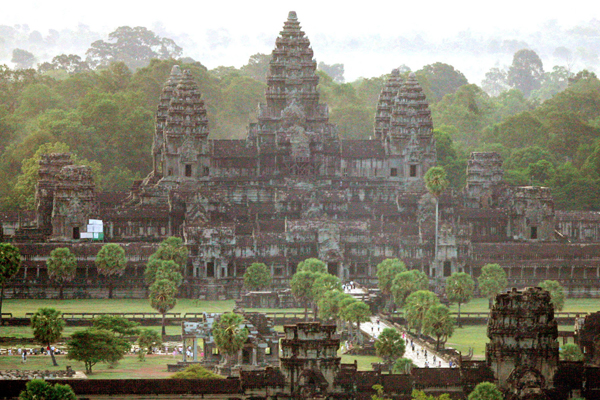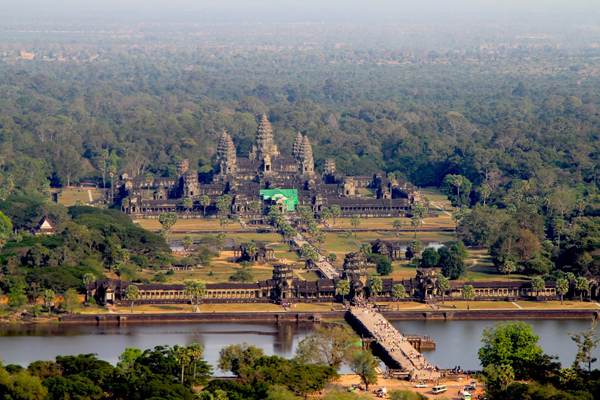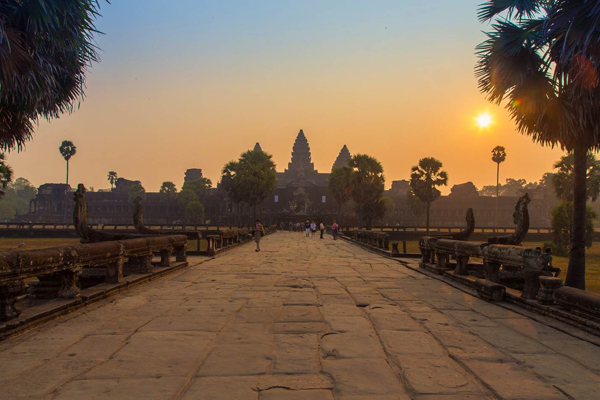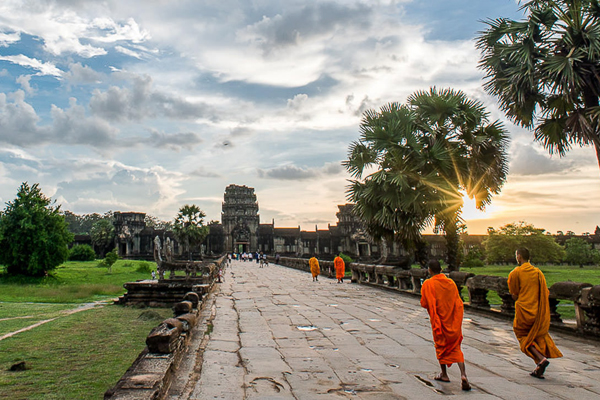The beautiful country in Indochina, Cambodia has been always talked about ancient palaces, spectacular temple complexes and the charming scenery as well. In the period of nearly four centuries from XII to XV, Angkor could be said to be the most bustling and prosperous in Cambodia where used to be the capital of powerful Khmer Empire. It is almost impossible to describe the total beauty of Angkor complex in an article, so I will pick Angkor Wat which is on top the greatest religious relics in the world and bear the perfect mark of ancient Khmer art in order to introduce.

Located in the center of Angkor, far from Phnom Penh 240 km to the north, Angkor Wat is the place of worship for Visnu – a God in Hinduism, built under King Surja-warman II (1113-1150). Angkor Wat used to be a Buddhism temple until XV century, the Khmer capital was destroyed by Siem, the Khmer King ran to Phnom Penh, from that Angkor Wat was forgotten between the old jungle and then was rediscovered in 1860 by Herri Mouhot- a French scholar. Angkor Wat has a circumference of nearly 6 kilometres and an area of about 200 hectares. This is the only temple in Cambodia has the main entrance in the west, towards the sunset.
Angkor Wat was built with countless pieces of green stones, which is a kind of mountain temple in Cambodia. Angkor Wat has 398 rooms, interconnected by a hallway of 1.500m. At the above side, there are 5 continuous towers by 3-tier of architecture, in which the highest tower is up to 65m high and the 4 towers are 40 meters high. The road to the main entrance of Angkor Wat is also made of rock which is 230 meters long, nearly l0 meters wide and 5 meters high compared to the lake water level on two sides of the temple. Generally, 398 spaces of the main temple are linked together in a coherent way.

The entire complex exist images of a lot of stone carvings reliefs like giant slabs, columns, doors, ceilings, walls, corridors, balustrades,etc. All of them seem to exude extraordinary power and skillful hands of the ancient Khmer people. The center is a three-floor architecture, connected together through the long and deep corridors. Any where tourists can encounter ingenious sculpts or reliefs based on old legendaries India epics Mahabharata and Raymana.
The most unique thing on the first floor may be the corridor with series of reliefs on the walls 2.5m with a length of more than 800m, describing the historical references in Brahmin and victories of King Suryavarman II – the creator. The innermost side of the reliefs describe the churning of the Ocean of Milk in the legend, the monkies and the battle of God Sita, the dance of fairy Aspara ... On the 1st floor of Angkor Wat, there are also lakes, where Kings often used for bathing, washing and stripping the sin.

The 2nd floor is a large yard surrounded by a block of walls, the inside space is the shrines of worship for gods. Besides, the 2nd floor has numerous carvings of Apsara bayaderes dancing with bare breasts and plentiful postures.
The 3rd floor is the top, with a height of 65 m, consisting of two cross corridors intersecting in the middle. The intersecting point of two corridors is center of Angkor Wat. There are lots of Buddha statues in the center. The highest tower of Angkor Wat is considered the accommodation of gods. Around the tower is four square hallways, in every corner of hallways is a lower tower. The central tower and four surrounding towers form the famous horizon of Angkor Wat when being seen from a distance.

In 2015, Angkor Wat even ranked the first position in top the most attractive destinations in the world by the famous travel website Lonely Planet with its own architecture style. This makes the number of tourists coming here grow exponentially. Besides enjoying the ancient wonder, visitors can get the knowledge of the heyday of Khmer Empire.

